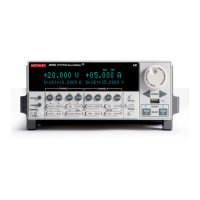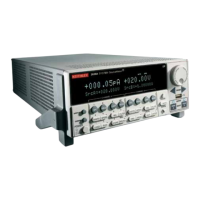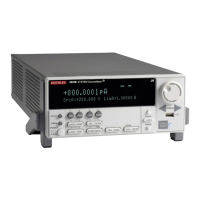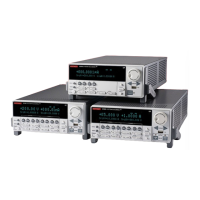2-2
SECTION 2
Two-terminal Device Tests
ings, R
1
and R
2
, are then obtained, and the voltage coefficient in
%/V can then be calculated as follows:
100 (R
2
– R
1
)
Voltage Coefficient (%/V) =
__________
R
1
(V
2
– V
1
)
where: R
1
= resistance calculated with first applied voltage (V
1
).
R
2
= resistance calculated with second applied voltage
(V
2
).
For example, assume that the following values are obtained:
R
1
= 1.01 × 10
10
W
R
2
= 1 × 10
10
W
(V
2
– V
1
) = 10V
The voltage coefficient is:
100 (1×10
3
)
Voltage Coefficient (%/V) =
__________
= 0.1%/V
1×10
10
(10)
2.3.3 Measurement Considerations
A couple of points should be noted when using this procedure to
determine the voltage coefficient of high megohm resistors. Keep
in mind that any leakage resistance in the test system will degrade
the accuracy of your measurements. To avoid such problems, use
only high quality test fixtures that have insulation resistances
greater than the resistances being measured. Using isolation resis-
tances 10× greater than the measured resistance is a good rule of
thumb. Also, make certain that the test fixture sockets are kept
clean and free of contamination as oils and dirt can lower the
resistance of the fixture and cause error in the measurement.
There is an upper limit on the resistance value that can be
measured using this test configuration. For one thing, even a
well- designed test fixture has a finite (although very high) path
isolation value. Secondly, the maximum resistance is determined
by the test voltage and current-measurement resolution of the test
instrument. Finally, the instrument has a typical output impe-
dance of 10
15
W. To maximize measurement accuracy with a given
resistor, use the highest test voltages possible.
2.3.4 Example Program 1: Voltage
Coefficient Test
Program 1 demonstrates programming techniques for voltage
coefficient tests. Follow the steps that follow to use the test pro-
gram. To reiterate, this test requires a single Source-Measure
channel. For this example, we will refer to the single-channel
Model 2601 System SourceMeter instrument. The test program
can be used with the multi-channel members of the Series 2600
family with no modification.
With the power off, connect the Model 2601 System Source-1.
Meter instrument to the computer’s IEEE-488 interface.
Connect the test fixture to the instrument using appropriate 2.
cables (see Figure 2-1).
Turn on the instrument, and allow the unit to warm up for 3.
two hours for rated accuracy.
Turn on the computer and start Test Script Builder (TSB). Once 4.
the program has started, open a session by connecting to the
instrument. For details on how to use TSB, see the Series 2600
Reference Manual.
You can simply copy and paste the code from Appendix A 5.
in this guide into the TSB script editing window (Program
1: Voltage Coefficient), manually enter the code from the
appendix, or import the TSP file ‘Volt_Co.tsp’ after down-
loading it to your PC.
If your computer is currently connected to the Internet, you
can click on this link to begin downloading: http://www.
keithley.com/data?asset=50914.
Install the resistor being tested in the test fixture. The first 6.
step in the operation requires us first to send the code to the
instrument. The simplest method is to right-click in the open
script window of TSB, and select ‘Run as TSP file’. This will
compile the code and place it in the volatile run-time memory
of the instrument. To store the program in non-volatile
memory, see the “TSP Programming Fundamentals” section of
the Series 2600 Reference Manual.
Once the code has been placed in the instrument run-time 7.
memory, we can run it simply by calling the function ‘
Volt _
Co()
’. This can be done by typing the text ‘
Volt _ Co()
’ after
the active prompt in the Instrument Console line of TSB.
In the program 8. ‘Volt_Co.tsp’, the function
Volt _
Co(v1src, v2src)
is created. The variables
v1src
and
v2src
represent the two test voltage values applied to the
device-under-test (DUT). If they are left blank, the function
will use the default values given to these variables, but you can
specify what voltages are applied by simply sending voltages
that are in-range in the function call. As an example, if you
wanted to source 2V followed by 10V, simply send
Volt _
Co(2, 10)
to the instrument.
The instrument will then source the programmed voltages 9.
and measure the respective currents through the resistor. The
calculated voltage coefficient and two resistance values will
then be displayed in the Instrument Console window of TSB.

